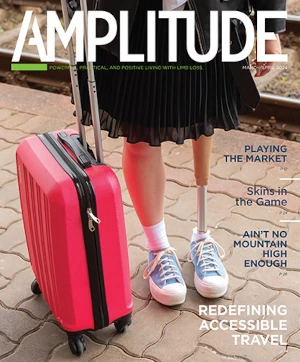A University of Texas at Dallas (UT Dallas) professor applied robot control theory to enable powered lower-limb prostheses to dynamically respond to the user’s environment and help individuals with amputations walk. Research shows that users of the robotic leg could walk on a moving treadmill almost as fast as an able-bodied person. The paper is available online and in an upcoming print issue of IEEE Transactions on Robotics.
“We borrowed from robot control theory to create a simple, effective new way to analyze the human gait cycle,” said Robert Gregg, PhD, assistant professor of mechanical engineering and bioengineering in the Erik Jonsson School of Engineering and Computer Science and lead author of the paper. “Our approach resulted in a method for controlling powered prostheses for amputees to help them move in a more stable, natural way than current prostheses.”
Gregg proposed a new way to view and study the process of human walking: measuring a single variable that represents the motion of the body. In this study, that variable was the center of pressure on the foot, which moves from heel to toe through the gait cycle. “We used advanced mathematical theorems to simplify the entire gait cycle down to one variable,” he said. “If you measure that variable, you know exactly where you are in the gait cycle and exactly what you should be doing.”
He first tested his theory on computer models, and then with three participants with transfemoral amputations at the Rehabilitation Institute of Chicago. He implemented his algorithms with sensors that measure the center of pressure on a powered prosthesis. Inputted with only the user’s height, weight, and dimension of the residual thigh into his algorithm, the prosthesis was configured for each subject in about 15 minutes. Subjects then walked on the ground and on a treadmill moving at increasing speeds.
“We did not tell the prosthesis that the treadmill speed was increasing. The prosthesis responded naturally just as the biological leg would do,” Gregg said.
The participants were able to move at speeds of more than one meter per second; the typical walking speed of fully able-bodied people is about 1.3 meters per second, Gregg said. The participants also reported exerting less energy than with their traditional prostheses.
“Our approach unified multiple modes of operation into one and resulted in technology that could help people in the future,” he said. “That and the feedback from participants were very rewarding.”
Gregg said the next step in the research will be to compare results of experiments with robotic legs using both the time paradigm and center of pressure paradigm.
Researchers from the Rehabilitation Institute of Chicago, Northwestern University, and the University of New Brunswick, Fredericton, Canada, were also involved in the study.
Editor’s note: This story was adapted from materials provided by UT Dallas.



